Get free scan and check if your device is infected.
Remove it nowTo use full-featured product, you have to purchase a license for Combo Cleaner. Seven days free trial available. Combo Cleaner is owned and operated by RCS LT, the parent company of PCRisk.com.
What is Provider?
Provider supposedly improves the Internet browsing experience by displaying coupons, enabling comparison shopping, and other functionality - "Provider is a free, ad-supported browser extension that you, or someone using your computer, has installed. Provider aims to enhance your Internet browsing experience".
Many users believe this browser plug-in to be legitimate and useful and go on to install it. In fact, this application is considered to be adware and a potentially unwanted program (PUP). Following infiltration, Provider collects Internet browsing-related information and generates intrusive online advertisements.
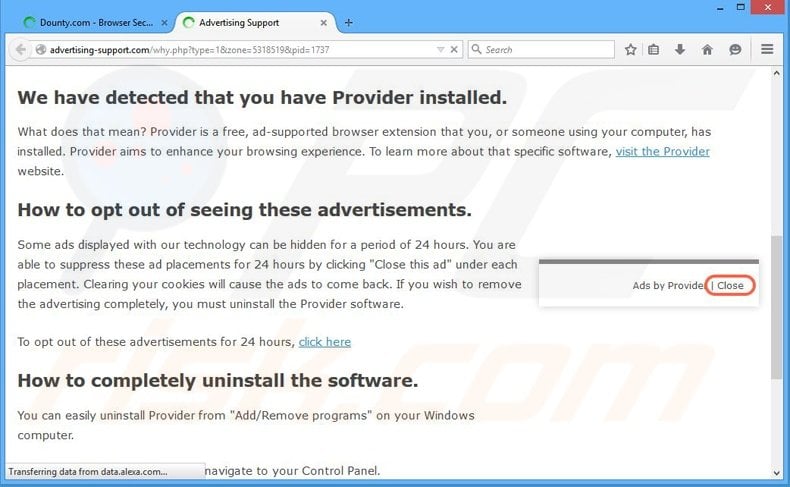
Most of the displayed advertisements are banners, pop-ups, and coupons. These are not the only advertisement types displayed by Provider adware. This app employs a virtual layer allowing placement of graphical content on visited websites. Some ads are opened in new browser tabs or windows.
Note that the displayed content does not originate from visited websites. Most ads lead to the Advertising Support website, however, there is a high probability that users will be redirected to infectious content. Therefore, clicking these ads can result in high-risk computer infections.
In addition, Provider adware tracks users' Internet browsing activity. The Privacy Policy of this app falsely states that collected information contains no personally identifiable information, and yet, search queries, websites visited, pages viewed, Internet Protocol (IP) addresses, and other collected details clearly contain private details (for example, bank account logins/passwords).
This information is later shared with third parties and can be misused to generate revenue for developers. Therefore, having information tracking apps installed on your system can result in serious privacy issues or even identity theft. For these reasons, Provider should be uninstalled immediately.
Provider is similar to many adware-type apps (for example, Shoppi, adsupply, and deals) that also display advertisements leading to the same website. Adware-type applications are very similar - most claim to provide features to improve the Internet browsing experience in various ways.
Their purpose, however, is to display advertisements and collect personally identifiable information. Rather than providing any real value for the user, Provider and other similar adware, is designed to generate revenue for the developers.
How did Provider install on my computer?
The developers of this bogus app employ a deceptive software marketing method called 'bundling' (stealth installation of third party apps together with regular software) to install Provider without users' permission. This method is effective, since many users do not pay enough attention when downloading and installing software. They also skip most of the download/installation steps without realizing that bogus apps such as Provider are hidden within the 'Custom' or 'Advanced' options. Therefore, they install these apps inadvertently without their consent.
How to avoid installation of potentially unwanted applications?
Your chosen software should be downloaded from a trusted source (usually the official website). When downloading from a freeware download website, select the direct download link, rather than the download manager.
Most popular freeware download websites monetize their traffic and free services via download managers that are designed to distribute additional apps together with the chosen software. If you are forced to use a manager, closely analyze each step of the procedure and click 'Decline' when installation of third-party apps is offered.
Furthermore, downloaded apps should be installed with the 'Custom' or 'Advanced' options - this will reveal any concealed applications listed for installation and allow you to opt-out.
Deceptive free software installer used in Provider adware distribution:

Intrusive online adverts displayed by Provide adware ('Ads by Provider'):
Instant automatic malware removal:
Manual threat removal might be a lengthy and complicated process that requires advanced IT skills. Combo Cleaner is a professional automatic malware removal tool that is recommended to get rid of malware. Download it by clicking the button below:
DOWNLOAD Combo CleanerBy downloading any software listed on this website you agree to our Privacy Policy and Terms of Use. To use full-featured product, you have to purchase a license for Combo Cleaner. 7 days free trial available. Combo Cleaner is owned and operated by RCS LT, the parent company of PCRisk.com.
Quick menu:
- What is Provider?
- STEP 1. Uninstall Provider application using Control Panel.
- STEP 2. Remove Provider adware from Internet Explorer.
- STEP 3. Remove Provider ads from Google Chrome.
- STEP 4. Remove 'Ads by Provider' from Mozilla Firefox.
- STEP 5. Remove Provider ads from Safari.
- STEP 6. Remove rogue plug-ins from Microsoft Edge.
Provider adware removal:
Windows 11 users:

Right-click on the Start icon, select Apps and Features. In the opened window search for the application you want to uninstall, after locating it, click on the three vertical dots and select Uninstall.
Windows 10 users:

Right-click in the lower left corner of the screen, in the Quick Access Menu select Control Panel. In the opened window choose Programs and Features.
Windows 7 users:

Click Start (Windows Logo at the bottom left corner of your desktop), choose Control Panel. Locate Programs and click Uninstall a program.
macOS (OSX) users:

Click Finder, in the opened screen select Applications. Drag the app from the Applications folder to the Trash (located in your Dock), then right click the Trash icon and select Empty Trash.
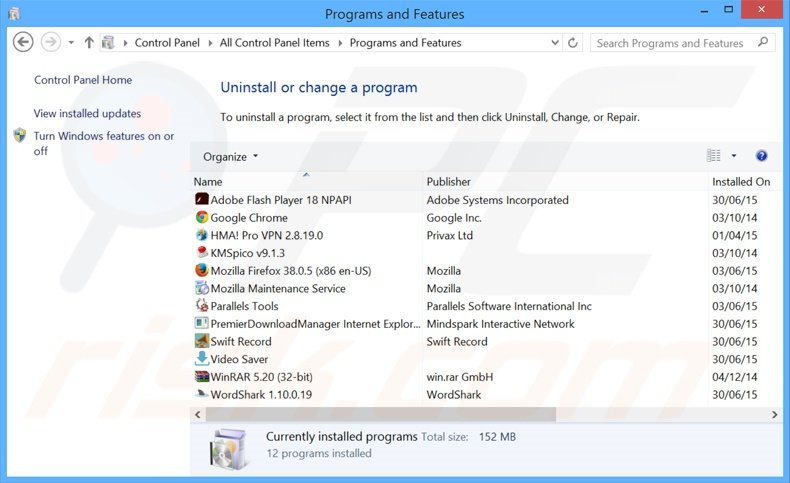
In the uninstall programs window, look for "Provider" and any other recently installed suspicious applications, select such entries and click "Uninstall" or "Remove".
After uninstalling the potentially unwanted program that causes Provider ads, scan your computer for any remaining unwanted components or possible malware infections. To scan your computer, use recommended malware removal software.
DOWNLOAD remover for malware infections
Combo Cleaner checks if your computer is infected with malware. To use full-featured product, you have to purchase a license for Combo Cleaner. 7 days free trial available. Combo Cleaner is owned and operated by RCS LT, the parent company of PCRisk.com.
Remove Provider ads from Internet browsers:
At time of research, Provider did not install its browser plug-ins on Internet Explorer, Google Chrome, or Mozilla Firefox, however, it was bundled with other adware. Therefore, you are advised to remove all potentially unwanted browser add-ons from your Internet browsers.
Video showing how to remove potentially unwanted browser add-ons:
 Remove malicious add-ons from Internet Explorer:
Remove malicious add-ons from Internet Explorer:
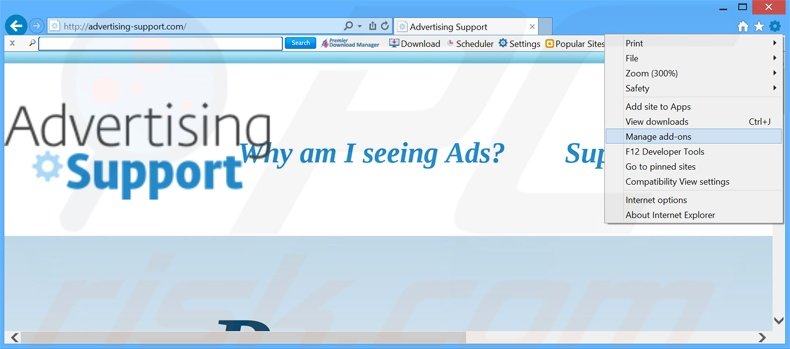
Click the "gear" icon ![]() (at the top right corner of Internet Explorer), select "Manage Add-ons". Look for any recently-installed suspicious browser extensions, select these entries and click "Remove".
(at the top right corner of Internet Explorer), select "Manage Add-ons". Look for any recently-installed suspicious browser extensions, select these entries and click "Remove".
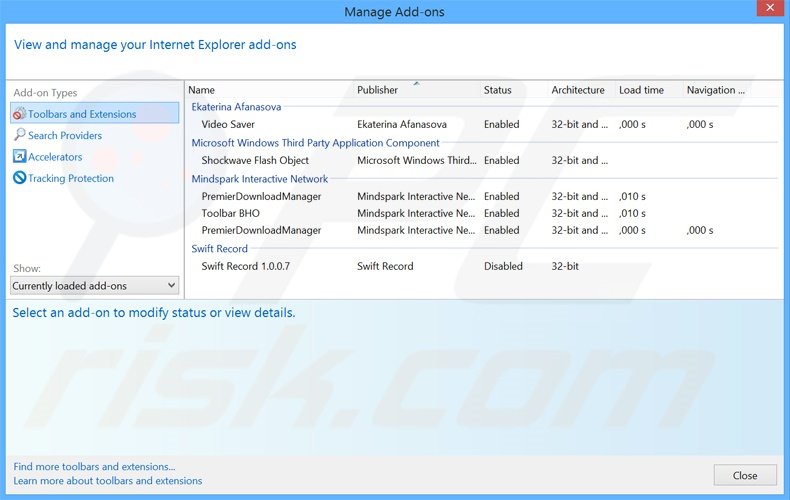
Optional method:
If you continue to have problems with removal of the provider adware, reset your Internet Explorer settings to default.
Windows XP users: Click Start, click Run, in the opened window type inetcpl.cpl In the opened window click the Advanced tab, then click Reset.

Windows Vista and Windows 7 users: Click the Windows logo, in the start search box type inetcpl.cpl and click enter. In the opened window click the Advanced tab, then click Reset.

Windows 8 users: Open Internet Explorer and click the gear icon. Select Internet Options.

In the opened window, select the Advanced tab.

Click the Reset button.

Confirm that you wish to reset Internet Explorer settings to default by clicking the Reset button.

 Remove malicious extensions from Google Chrome:
Remove malicious extensions from Google Chrome:
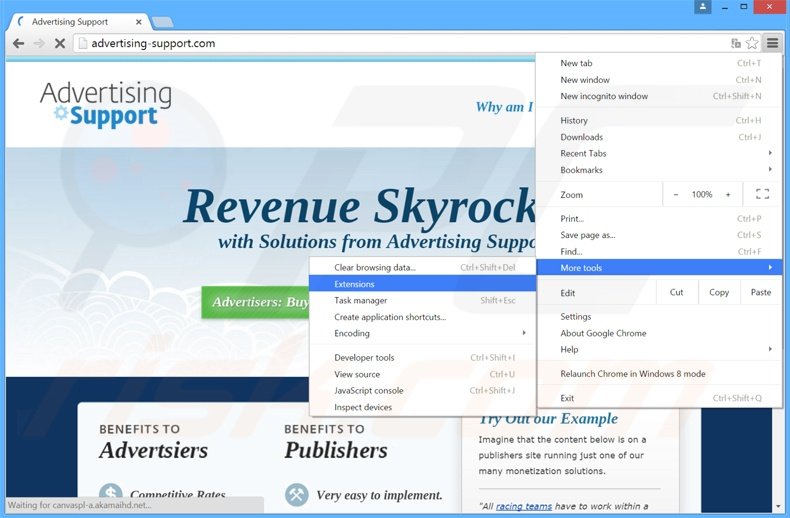
Click the Chrome menu icon ![]() (at the top right corner of Google Chrome), select "Tools" and click "Extensions". Locate all recently-installed suspicious browser add-ons, select these entries and click the trash can icon.
(at the top right corner of Google Chrome), select "Tools" and click "Extensions". Locate all recently-installed suspicious browser add-ons, select these entries and click the trash can icon.
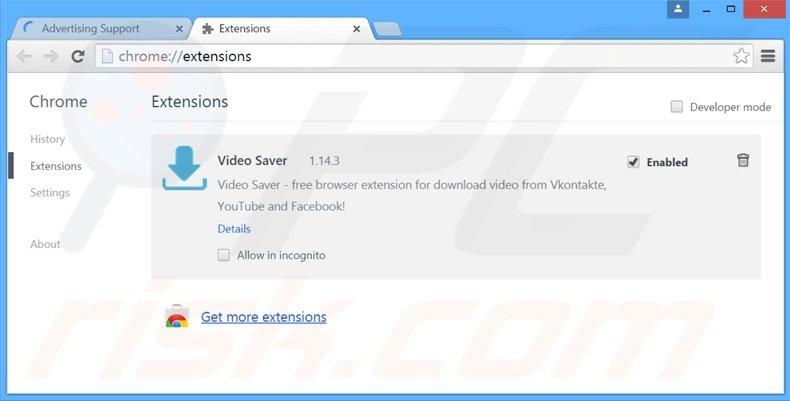
Optional method:
If you continue to have problems with removal of the provider adware, reset your Google Chrome browser settings. Click the Chrome menu icon ![]() (at the top right corner of Google Chrome) and select Settings. Scroll down to the bottom of the screen. Click the Advanced… link.
(at the top right corner of Google Chrome) and select Settings. Scroll down to the bottom of the screen. Click the Advanced… link.

After scrolling to the bottom of the screen, click the Reset (Restore settings to their original defaults) button.

In the opened window, confirm that you wish to reset Google Chrome settings to default by clicking the Reset button.

 Remove malicious plug-ins from Mozilla Firefox:
Remove malicious plug-ins from Mozilla Firefox:
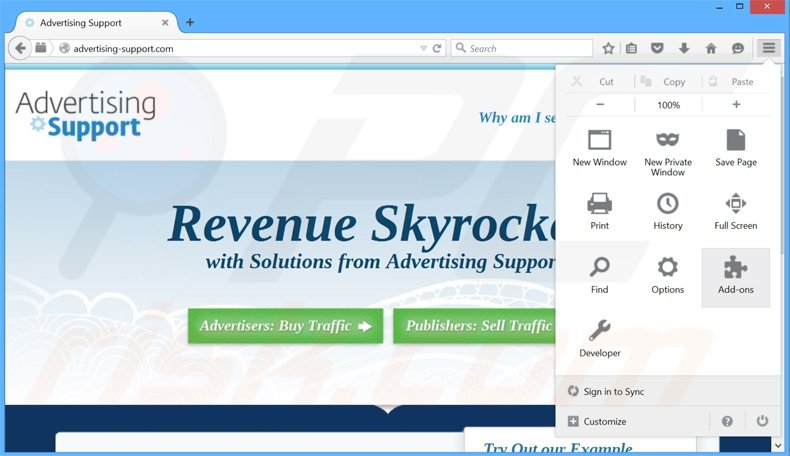
Click the Firefox menu ![]() (at the top right corner of the main window), select "Add-ons". Click "Extensions", in the opened window, remove all recently-installed suspicious browser plug-ins.
(at the top right corner of the main window), select "Add-ons". Click "Extensions", in the opened window, remove all recently-installed suspicious browser plug-ins.
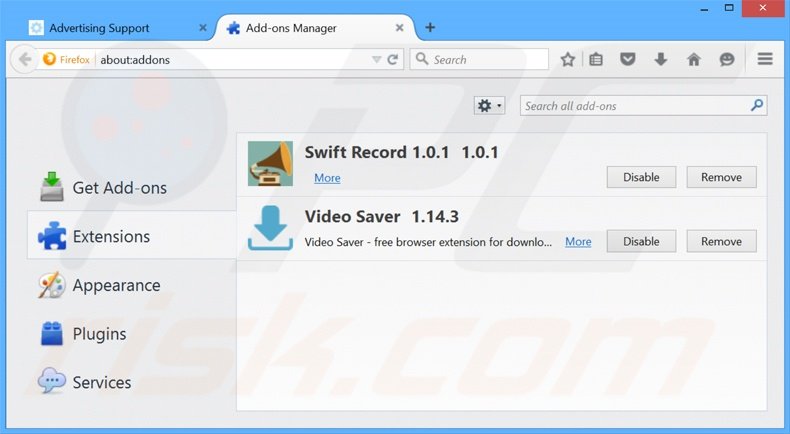
Optional method:
Computer users who have problems with provider adware removal can reset their Mozilla Firefox settings.
Open Mozilla Firefox, at the top right corner of the main window, click the Firefox menu, ![]() in the opened menu, click Help.
in the opened menu, click Help.

Select Troubleshooting Information.

In the opened window, click the Refresh Firefox button.

In the opened window, confirm that you wish to reset Mozilla Firefox settings to default by clicking the Refresh Firefox button.

 Remove malicious extensions from Safari:
Remove malicious extensions from Safari:

Make sure your Safari browser is active, click Safari menu, and select Preferences....

In the opened window click Extensions, locate any recently installed suspicious extension, select it and click Uninstall.
Optional method:
Make sure your Safari browser is active and click on Safari menu. From the drop down menu select Clear History and Website Data...

In the opened window select all history and click the Clear History button.

 Remove malicious extensions from Microsoft Edge:
Remove malicious extensions from Microsoft Edge:

Click the Edge menu icon ![]() (at the upper-right corner of Microsoft Edge), select "Extensions". Locate all recently-installed suspicious browser add-ons and click "Remove" below their names.
(at the upper-right corner of Microsoft Edge), select "Extensions". Locate all recently-installed suspicious browser add-ons and click "Remove" below their names.

Optional method:
If you continue to have problems with removal of the provider adware, reset your Microsoft Edge browser settings. Click the Edge menu icon ![]() (at the top right corner of Microsoft Edge) and select Settings.
(at the top right corner of Microsoft Edge) and select Settings.

In the opened settings menu select Reset settings.

Select Restore settings to their default values. In the opened window, confirm that you wish to reset Microsoft Edge settings to default by clicking the Reset button.

- If this did not help, follow these alternative instructions explaining how to reset the Microsoft Edge browser.
Summary:
 Commonly, adware or potentially unwanted applications infiltrate Internet browsers through free software downloads. Note that the safest source for downloading free software is via developers' websites only. To avoid installation of adware, be very attentive when downloading and installing free software. When installing previously-downloaded free programs, choose the custom or advanced installation options – this step will reveal any potentially unwanted applications listed for installation together with your chosen free program.
Commonly, adware or potentially unwanted applications infiltrate Internet browsers through free software downloads. Note that the safest source for downloading free software is via developers' websites only. To avoid installation of adware, be very attentive when downloading and installing free software. When installing previously-downloaded free programs, choose the custom or advanced installation options – this step will reveal any potentially unwanted applications listed for installation together with your chosen free program.
Post a comment:
If you have additional information on provider adware or it's removal please share your knowledge in the comments section below.
Share:

Tomas Meskauskas
Expert security researcher, professional malware analyst
I am passionate about computer security and technology. I have an experience of over 10 years working in various companies related to computer technical issue solving and Internet security. I have been working as an author and editor for pcrisk.com since 2010. Follow me on Twitter and LinkedIn to stay informed about the latest online security threats.
PCrisk security portal is brought by a company RCS LT.
Joined forces of security researchers help educate computer users about the latest online security threats. More information about the company RCS LT.
Our malware removal guides are free. However, if you want to support us you can send us a donation.
DonatePCrisk security portal is brought by a company RCS LT.
Joined forces of security researchers help educate computer users about the latest online security threats. More information about the company RCS LT.
Our malware removal guides are free. However, if you want to support us you can send us a donation.
Donate







▼ Show Discussion